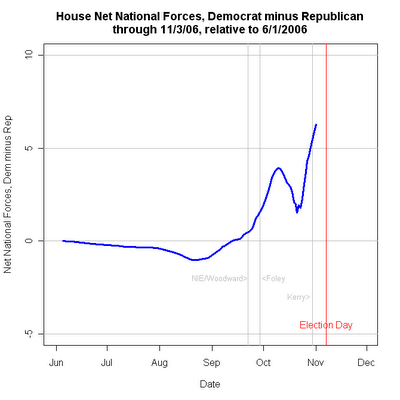
I estimated the net national forces in the Senate rate last night. Here is the same estimation procedure applied to the House. This is based on 86 House races with a total of 380 polls. This is much less dense than the Senate data, but the results are surprisingly stable. Unlike the Senate, however, the data do not extend back in time very far, so the starting point here is June 1, 2006. The size of the effects here are also NOT comparable to the Senate forces, since both are estimated independently and the zero point is arbitrary in both cases. Relative movement is meaningful, so it is fine to say that since June 1 the net national forces in the House (for these 86 races) have risen about 6 percentage points.
As with the Senate, this is a good explanation for why so many House seats held by Republicans are now competitive. UNLIKE the Senate, these effects appear to have continued to grow recently. Even a much rougher fit still produces the upward rise at the end. This also is consistent with the growth in the Democratic advantage on the generic ballot, though the details of the dynamics are somewhat different.
The evidence then is favorable to larger than anticipated Democratic gains in the House, but smaller gains in the Senate, at least as of November 3. Four days to go.
Click here to go to Table of Contents